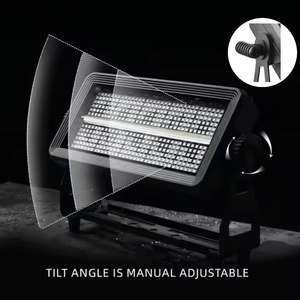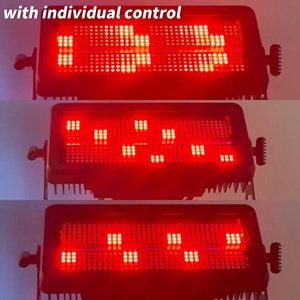(383 products available)







































































































































































































A strobo light is a powerful lighting tool used in various environments. Stroboscopic lights are used in nightclubs to create a lively atmosphere, on stage during a performance to enhance the visual experience, or on a police car to signal emergencies. Regardless of the environment, strobo lights come in different types designed to suit various applications. Here are some common types of strobo lights:
When purchasing a stroboscope light, buyers should be aware of the specifications to meet their needs. Common strobo light specifications include the following.
Light Source
Strobe lights use halogen, LED, or Xenon bulbs as their light source. Xenon bulbs produce extremely bright flashes and are commonly used in emergency and high-intensity strobe lights. While LED bulbs are energy-efficient and long-lasting, they may not produce as bright light as Xenon bulbs.
Intensity and Output
The intensity and output of strobe lights are measured in lumens. This is the amount of visible light the strobe light emits. For example, a high-intensity strobe light may have an output of 10,000 lumens, producing extremely bright flashes of light. Different strobe lights have varying intensity levels, with some having an output of 500 to 20,000 lumens or more.
Flash Rate
Strobe lights have different flash rates measured in hertz (Hz). Hertz is the number of flashes per second. For example, a strobe light with a flash rate of 2 Hz will produce two flashes of light every second. Typically, the flash rate ranges from 1 to 10 Hz or more for specialized lights.
Duration of Flash
The duration of each flash is measured in milliseconds (ms). This is the length of time the light is emitted during a flash. For instance, a strobe light with a flash duration of 10 ms will have short bursts of light, while a flash duration of 100 ms will produce longer flashes. Flash durations typically range from 1 to 100 ms or more.
Control Options
Strobe lights come with control options that allow users to adjust settings to meet their needs. These control options include:
Power Source
Strobe lights can use different power sources, including 12V, 24V, or 220V AC power. Some strobe lights also come with rechargeable batteries, making them portable.
Maintaining strobe lights is essential to ensure they work efficiently and have a long lifespan. Here are some general maintenance tips for strobo lights.
Purpose
Strobo lights are available in different types to meet various needs. First, it is essential to define the intended purpose of the strobo light. Is it for a party, concert, DJ performance, or exhibition display? Different settings may require different levels of intensity and features.
Brightness and Effects
Consider the brightness level and the type of light effects produced by the strobo light. Some models have adjustable brightness levels, while others have fixed output levels. Additionally, consider whether the lights can create multi-colored or special lighting effects.
Portability and Size
Strobo lights come in various sizes, from compact handheld models to larger fixtures. Consider the size and weight of the strobo lights and whether they are easy to transport and set up. If portability is a significant factor, consider lightweight and compact options.
Control Options
Strobo lights can be controlled in various ways, such as manually, through sound activation, or via DMX control. Determine the desired control options based on the performance or event requirements. DMX control allows for more advanced and synchronized control of multiple lights.
Power Supply
Consider the power supply requirements of the strobo lights. Some models use batteries, while others require a standard electrical outlet. If using them outdoors or in locations with limited power access, battery-operated or portable options may be more convenient.
Durability and Reliability
Choose strobo lights from reputable manufacturers known for producing durable and reliable products. Reading customer reviews and comparing warranties can assist in determining the reliability and longevity of the chosen strobo lights.
Budget
Establish a budget for purchasing strobo lights. Prices may vary based on brand, features, and performance level. Compare different options and choose the ones that offer the best value within the allocated budget.
Additional Features
Some strobo lights may have additional features that enhance their functionality. These may include remote control, built-in programs, sound sensitivity, and synchronization with music or other lights. Consider whether these additional features are important for the intended use.
By considering these factors, users can choose the right strobo lights that fit their needs and preferences, creating an exciting and dynamic atmosphere for any event or performance.
It is very easy to replace a strob light, as only a few simple tools are needed, and one can do it in a short time. The tools that will be required are a screwdriver, wire strippers, and electrical tape. Replacement parts needed include new strobo lights and mounting hardware. Here is a step-by-step guide on how to replace strob lights.
1. Turn Off Power Supply
The first step when replacing a strobe light is to turn off the power supply to avoid electric shock.
2. Remove the Old Strobe Light
The old strobe light is removed using a screwdriver. After it has been unscrewed, it is gently pulled away from the surface it was mounted on.
3. Disconnect the Wires
The wires connecting the old strobe light are disconnected. If one is not sure where the wires are connected, they can take a picture before disconnecting them.
4. Prepare the New Strobe Light
The new strobe light should be assembled according to the manufacturer's instructions before installation.
5. Connect the Wires
The wires in the new strobe light are connected to the wires in the vehicle. The connections are done using wire nuts or electrical tape, and ensure that the connections are secure to prevent any electrical faults.
6. Mount the New Strobe Light
The new strobe light is mounted onto the desired surface using a screwdriver. The mounting hardware should be securely fastened to ensure the light is firmly attached.
7. Turn On Power Supply
After the installation is complete, the power supply is turned on to test if the light is working as required.
Q1: What is the purpose of a strobe light?
A1: Strobe lights are often used as warning signals in emergency situations because they can attract people's attention.
Q2: How does a strobe light work?
A2: A strobe light generates a high-intensity flash of light by discharging a capacitor through an electrode in a gas-filled tube. The gas in the tube is generally neon.
Q3: Where are strobe lights commonly used?
A3: Strobe lights are commonly used in various settings, including photography, concerts, nightclubs, and as warning signals in emergency vehicles.
Q4: What are the different types of strobe lights?
A4: There are several types of strobe lights, including electronic strobe lights, xenon strobe lights, and LED strobe lights, each using different technologies to produce high-intensity flashes of light.
The web search volume for the keyword "strobo light" has shown significant fluctuations over the past year, with an average monthly web search volume of 40,500. Notably, there was a substantial three-month increase of 22%, contrasting sharply with a one-year decrease of 45%. This trend is evident from the monthly data, which peaked at 74,000 web searches in November 2023 and stabilized around 40,500 from December 2023 to October 2024, with a dip to 33,100 during the months of June to August 2024.
Analyzing the monthly search data reveals that "strobo light" experienced its highest interest in November 2023, likely due to seasonal events such as Halloween and festive decorations. Following November, the web search volume saw a consistent decline, reaching its lowest in the summer months of June to August 2024. This pattern suggests a strong seasonal influence, with spikes during holiday seasons and dips during off-peak times.
The observed trends in web search volume for "strobo light" indicate a clear dependency on seasonal consumer behavior. The significant increase in November aligns with the demand for festive lighting, while the subsequent decrease can be attributed to a lesser need for such products outside of holiday seasons. This insight into consumer search behavior could be crucial for businesses and marketers in planning inventory and promotional strategies around peak search times.